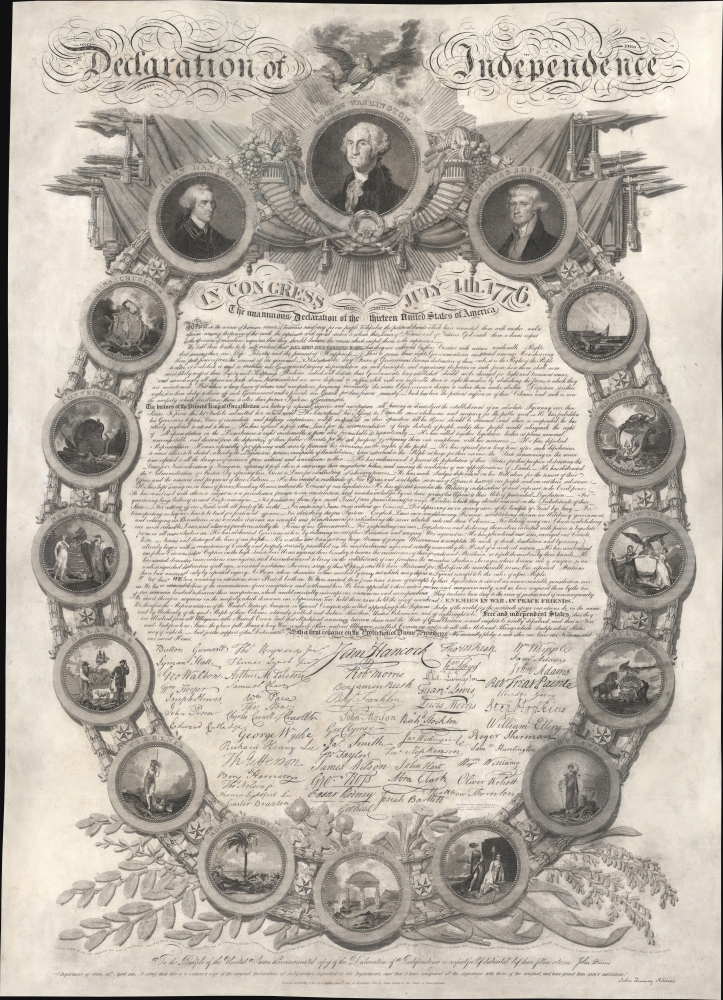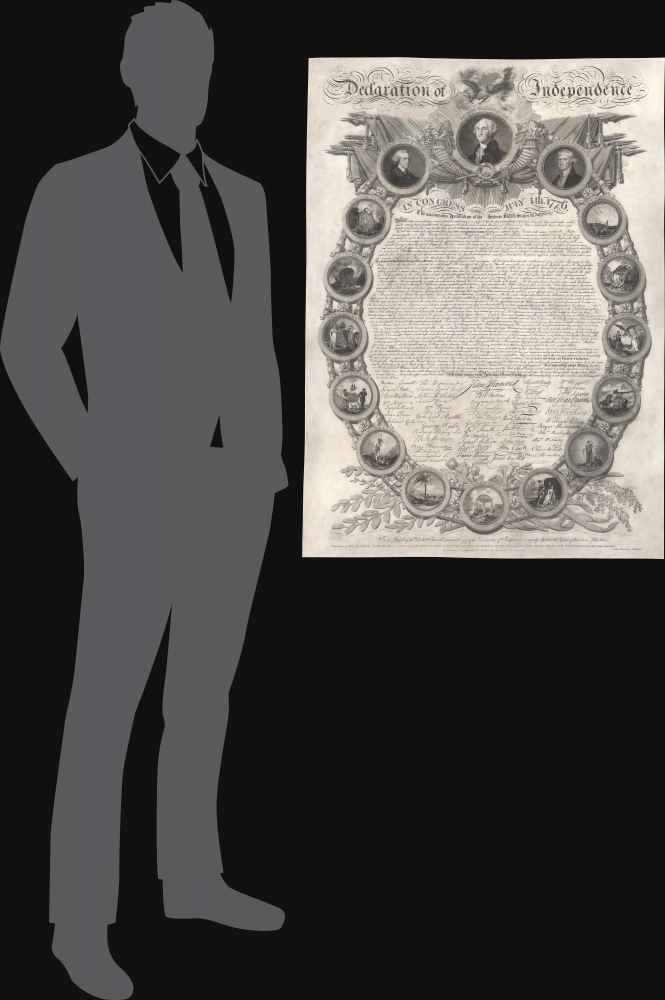1819 Binns Broadside Declaration of Independence
DeclarationofIndependence-binns-1819
Title
1819 (dated) 36 x 26 in (91.44 x 66.04 cm)
Description
Competing Copies of the Declaration
In the wake of the War of 1812, a wave of patriotism overtook the United States. With it, a market for the symbols of national identity arose. At the time, despite being a well-known document, the Declaration of Independence was viewable only by a select elite. Binns was the first to recognize the public appetite for a high-quality copy suitable for framed display. In 1816, he publicly proposed the project, which called for facsimiles of the signatures and the seals of signatory colonies.The idea was immediately seized upon by others, most specifically the rival publisher Benjamin Owen Tyler. While both rushed to complete their broadsides, work on the Binns engraving was slowed by his own ambitious standards. Tyler, whose planned broadside was much simpler, won out, publishing his copy of the Declaration in 1818. The Binns publication, as here, was issued one year later in 1819. Despite not being the first (only by a matter of months), it is by far the superior production, with fine engraving, superb detail, and elaborate embellishments. The third copy of the Declaration of Independence, meant to be an exact copy of the original, was issued in 1823 by William Stone.
Binns' Own Description
When submitting the 1818 unfinished proof for copyright, Binns included his own description of the planned masterpiece,A Splendid Edition of the Declaration of Independence. The Design in imitation of Bas Relief, will encircle the Declaration as a cordon of honor, surmounted by the arms of the United States. Immediately underneath the arms, will be a large medallion portrait of General George Washington, supported by cornucopiae, and embellished with spears, flags, and other Military trophies and emblems. On the one side of this medallion portrait, will be a similar portrait of John Hancock, . . . and on the other, a portrait of Thomas Jefferson, author of the Declaration of Independence.He further outlines his work and process in an 1819 letter to John Adams,
The arms of 'The Thirteen United States' in medallion, united by wreaths of olive leaves, will form the remainder of the cordon, which will be further enriched by some of the characteristic productions of the United States; such as the Tobacco and Indigo plants, the Cotton Shrub, Rice etc. The facsimiles will be engraved by Mr. Vallance, who will execute the important part of the publication at the City of Washington, where, by permission of the Secretary of State, he will have the original signatures constantly under his eye.
I have the honor herewith to send an unfinished copy of a splendid edition of the Declaration of Independence. It has been in the Engraver's hands more than three years and I have spared neither labor nor expense to give to the world such an edition as shall not be altogether unworthy the noble instrument which it will assist to familiarize to the eyes and make dear to the affections not only of Americans but of Mankind.
Publication History and Census
Binns credits the many engraves, painters, and other artists involved with the production of this broadside. George Murray engraved the ornamental portions, the arms of the United States, and the 13 state medallions. Charles H. Parker designed and engraved the text. James Barton Longacre engraved the portraits. The signatures facsimiles are the work of Tanner, Vallance, Kearny and Co. It was printed by Philadelphia printer James Porter.The exact printing count is unknown, but the National Park Service estimates that about 100 survive. The piece is scarce on the market. It has appeared in several auctions in the past 30 years, with prices ranging from 6,000 to 40,000 USD. The present example compares favorably with the best of these.
CartographerS
John Binns (December 22, 1772 - June 16, 1860) was an Irish-American journalist, engraver, radical politician, and publisher. Binns was born in Dublin, Ireland to a wealthy ironmonger, also John Binns. His father died when he was young, and his mother remarried the lawyer George McEntegarte - who proved abusive to both John and his brother Benjamin (1771 - c. 1857). The brothers fled to their grandfather's home in Dublin, where they attended the Sisson Putland Darling's (1737 - 1817) school. John was later apprenticed as a chandler and soaper. As a young man he relocated with his brother Benjamin Binns, to London where they became political radicals with the London Corresponding Society. John, a gifted public speaker, became chairmen of that organization's general committee in 1795. He traveled throughout England preaching Paineite Radicalism and violent revolution. His political leanings caused him to be arrested and imprisoned several times. The ground getting too hot for them in London 1801, the brothers immigrated to the United States, settling in Baltimore. There they joined the deist New York Society of Theophilanthropists, which advocated a freethinking, democratic, republican society. In 1802, he founded a radical left newspaper, the Republican Argus in Northumberland, Pennsylvania. Later, from 1807 to 1829, he published the Philadelphia Democratic Press, then Pennsylvania's leading Democratic newspaper. His political beliefs in included the territorial annexation of Canada and global American imperialism - with the idea being to forcibly spread democracy. Binns is best known for his 1819 issue of a highly decorative ceremonial broadside of the Declaration of Independence. He also published an autobiography in 1854 and died in Philadelphia in 1857. More by this mapmaker...
John Vallance (1770 - June 14, 1823) was a Philadelphia based engraver active in the late 18th and early 19th centuries. Vallance was born in Glasgow, Scotland. Some scholars claim he apprenticed under Philadelphia engraver James Trenchard, but the dates don't work, as Vallance moved to the United States at 21, already an master engraver. At 21, in the year 1791, Vallance moved to Philadelphia and immediately partnered with James Thacakara, his wife's (a Trenchard?) uncle, establishing the imprint of Thackara and Vallance. The firm completed numerous significant cartographic projects, including maps for Andrew Ellicott, John Melish, Henry S. Tanner, and Reading Howell. Vallance later partnered with Henry Schenck Tanner (1786 - May 18, 1858) and Francis Kearney, forming Vallance, Kearney and Co. Vallance, working with Thackara, produced some of the most important early maps of Washington D.C., engraved early Continental Currencies, and worked on Dobson's Encyclopedia. In addition to his cartographic work, Vallance was also one of the founding members of the Philadelphia based Association of Artists in America. Learn More...
James Barton Longacre (August 11, 1794 - January 1, 1869) was an American portraitist and engraver. He was born on a farm in Delaware County, Pennsylvania, the descendent of the early Swedish settler to that region. At 12, Longacre moved to Philadelphia, apprenticing himself at John E. Watson's bookstore. He was nonetheless more inclined towards the arts, and so in 1813, he transferred his apprenticeship to George Murray, principal in the engraving firm Murray, Draper, Fairman and Co. at 47 Sansom Street, Philadelphia. He started his own engraving business in 1819 at 230 Pine Street - his first project being John Binns' spectacular 'Declaration of Independence' broadside where he engraved portraits of George Washington, Thomas Jefferson, and John Hancock. Although regarded as the 'finest engraver in the United States', his business lagged during the Panic 1837, and he was forced into insolvency. For a time he traveled the Midwest as an itinerant bookseller, but in 1844, returned to Philadelphia where he became the 4th chief engraver of the Philadelphia Mint. There he made his mark as the designer of both the Flying Eagle Cent and the Indian Head Cent. He left the position of Chief Engraver in 1851, but remained active designing coinage for the rest of his career. He died suddenly at his home in Philadelphia on January 1, 1869. Learn More...




